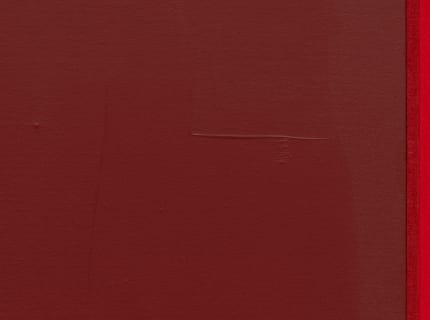Gray dominates Jennie C. Jones’s paintings, seven of which comprised her exhibition “Amplitude.” Cool and crisp, it is the color of the sound-absorbing panel layered atop canvas in Dark Tone, Red Pause, Gray Hush; warm and woolly, it is the color of the rectangular panel that she uses as her base for steely stripes of acrylic in Gray Measure with Muted Tone Burst; light and tinged with blue, it streaks a ground of white in Emanating Hum (all works 2016). But it is never just a color. Gray, Jones has written, is a “non color all color mixed together with a drop of light,” a “reflection of multiplicity, of the anti-essentialist times we currently occupy.” It is also, she reminds us, “the color of concrete.” In other words, Jones’s grays—whether they are slate, heather, drab, or pearly—are always weighted.
Jones is a powerful wordsmith, one who approaches language as yet another material. Her titles deploy the vocabulary of music, and the evocation of sound permeates these works—bringing to mind, say, the convergences between jazz and abstraction, the muffling of African American avant-gardists, and the tendency of the establishment to absorb and then gentrify experimental practices. With their use of acoustic panels as both figure and ground, it is hard not to read Jones’s paintings as extended metaphors. Yet metaphor never entirely disrupts a prolonged encounter with the exquisite abstractions themselves. Gray Measure with Muted Tone Burst, for example, is a stunning relief, in which a long, feltlike panel abuts a two-foot-square gray-on-white painting that here occupied a corner of the gallery. Jones also created a new audio piece for the exhibition. Red, Cue, Disruption reworks a 2008 piece, Cue, Search, which is itself a collage of a cassette recording of jazz drummer Elvin Jones. Available for download and streaming, but not playing in the gallery, the three-minute-and-thirty-three second treasure feels more like an audio guide than a work in itself, which does neither the music nor the painting justice.
The final work in “Amplitude” was a small, stubbornly horizontal diptych. A gray-on-white painting, like that in Gray Measure but half the size, is topped by a brown-gray acoustic panel; hung less than an inch away is the diptych’s right-hand component, a one-by-three-foot section of bright crimson. The work forms a layered, broken line, recalling the way video clips are spliced together in editing software. Then there is its title: Red Measure, Muted and Clipped. The inescapable evocation of video footage of police murders is wrenching. On a wave of emotion, Jones has pierced the concrete that has steadied her. The work serves to reinforce how full—how ample—Jones’s practice is, and how critical her project.
...
Read review at artforum.com.

